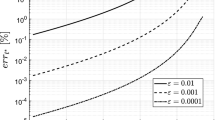Abstract
In statistical Keplerian systems the disordered component of collisionally induced motion of matter introduces new terms into the flux vector. This contribution, which is calculated from a transport equation, tends to reduce the density gradient and causes the expansion which is observed in computer simulations of collisional systems. A quantitative comparison with Trulsen's (1972) simulations confirms the revised expression of the flux vector.
Similar content being viewed by others
References
Hämeen-Anttila, K. A.: 1975,Astrophys. Space Sci. 37, 309.
Hämeen-Anttila, K. A.: 1976,Astrophys. Space Sci. 43, 145.
Hämeen-Anttila, K. A.: 1977a,Astrophys. Space Sci. 46, 133.
Hämeen-Anttila, K. A.: 1977b,Astrophys. Space Sci. 51, 429.
Trulsen, J.: 1972,Astrophys. Space Sci. 17, 241.
Author information
Authors and Affiliations
Rights and permissions
About this article
Cite this article
Hämeen-Anttila, K.A. A revised flux vector for the collisional evolution of Keplerian orbits. Astrophys Space Sci 56, 421–430 (1978). https://doi.org/10.1007/BF01879573
Received:
Issue Date:
DOI: https://doi.org/10.1007/BF01879573




